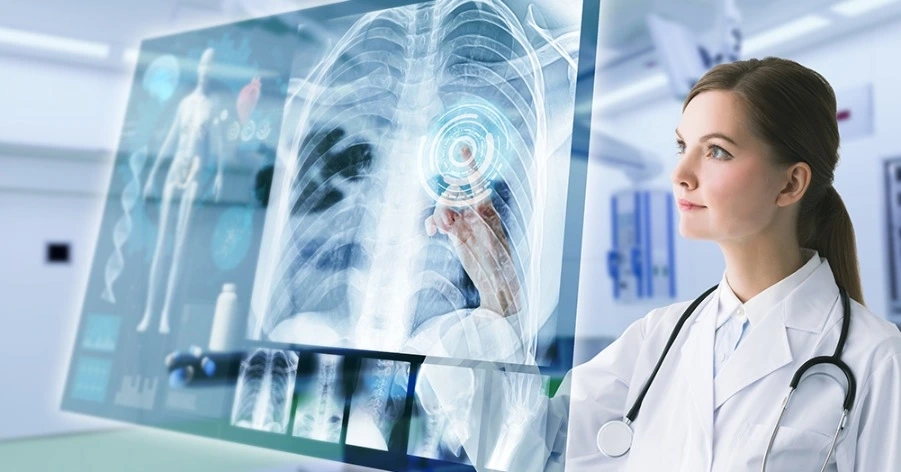

Teleradiology
Emerging Techniques in Radiology By Dr. Namita
Introduction
Radiology has always been the fastest adapting area of health care, and we have realized that efficiency in radiology is very valuable in efficient delivery of health care. This comes in the form of decreasing the time taken by radiologists, decreasing the amount of radiation, and balancing this out with an increased amount of information about the patient from each scan, which is what we focus on in this article.
Dr. Namita Sinha Verma, Head, Global Teleradiology and Coordinator Clinical Affairs, Governance Council, Aster Medical Imaging, Aster DM Healthcare shares insight into emerging innovations in radiology such as hybrid imaging and artificial intelligence.
The division of radiology has always been the fastest adapting area of health care and a pioneer in the integration of different fields of study. When considering the overarching aim of healthcare in the coming years, we have realised that efficiency is most valuable. This comes in the form of decreasing the time taken by radiologists, decreasing the amount of radiation, and balancing this out with an increased amount of information about the patient from each scan.
In this article, the adapting areas of radiology will be expanded upon while considering our aim of efficiency.
Technological Advances
In recent years, the field of healthcare and technology have worked together to create devices that aid radiologists.
- Carestream has pushed the frontiers of radiology with their newest and advanced medical imaging techniques: Digital Tomosynthesis and Dual Energy. Digital Tomosynthesis separates overlying structures in the body which makes it more efficient than traditional two-dimensional images. Essentially, it separates pathology and anatomy to give a clearer idea of the patient’s body. Whereas Dual Energy also works on the principle of separation by switching between high and low energy exposures to capture two images of each slice: one which deals exclusively with bones and the other which focuses on soft tissue.
- The Eclipse Image Processing System integrates some of these features to increase efficiency in radiology by providing one platform for intuitive scans.
- The advancement of two-dimensional images to three-dimensional is also a vital cornerstone of the future of radiology. The OnSight System creates scans of incredibly high resolution.
- In fact, breast tomosynthesis is now the standard of care for mammography screening. ProFound AI is an accurate solution for digital breast tomosynthesis (DBT). Radiologists are equipped to view each tissue and cancer is hereby detected to up to 8 per cent sooner on average.
- These changes are tied very closely with the storage space and computational power of modern computers at a relatively low cost. Where a three-dimensional file could not be stored on a system, now networking speed has increased from 10 megabytes / second to about 10 gigabytes / second, allowing for easy transmission of this three-dimensional data.
- The MRI Glove is a device that was introduced at the NYU School of Medicine. It helps provide clear, consistent images of a patient’s moving joints and tendons.
- Radiotracers have also been invented recently which are vital for diagnosis of something like Alzheimer’s. In nuclear imaging, a patient ingests radioactive materials or radiotracers before a scan. A camera will focus on sections where the radioactive material concentrates. This also helps enormously with the diagnosis of thyroid disease, gall bladder disease, heart conditions and cancer. Amyloid PET Imaging works similarly where amyloid plaque builds up for Alzheimer’s patients.
Artificial Intelligence
Talk of artificial intelligence has been a staple of most conversations and articles centred on radiology in the last decade. However, the actual implementation of AI is still quite slow because of the uniqueness and novel tech it is. Although, in the future, it will completely change the face of radiology in multiple ways. It has been predicted AI in the medical imaging market will rise from $21 billion to $264.85 billion by 2026.
- Hyperautomation is what most people first think of when introduced to AI: the automation of mundane tasks with the use of AI and Machine Learning. This is valuable in multiple fields, ranging from patient communication (real-time updates can be provided to patients and patient information can be collected and processed immediately) to detect subtle changes in a scan. Robotic process automation (RPA), intelligent business management software (iBPMS) and AI are combined for this.
- Google’s DeepMind is a software that can read three-dimensional retinal OCT scans as well as diagnose fifty ophthalmic conditions with a 99% accuracy rate.
- Another less explored area of Artificial Intelligence in healthcare is an automatic reallocation of workflow and time for radiologists. This would include automatic escalation and assignment of studies based on the availability of the radiologist, location, subspecialties, and time of day. This is necessary as certain scans are of importance but may not always be prioritised immediately and the system makes this workflow a lot simpler.
- AI is necessary for cybersecurity as well. Nearly four out of five industries to witness a breach in cybersecurity involved a healthcare organisation in 2019. Healthcare data breaches will total more than $4 billion by 2022. It would protect AI-powered systems training data, ML models as well as training pipelines.
Augmented Intelligence
Augmented Intelligence is perhaps the most realistic and important field to study at this point in time. Simply put, it is the world of collaboration between AI and humankind. Radiologists are at the forefront of a new and exciting world of technology, and it is their responsibility to engage with the advancements of their field.
- Physicians are further equipped to create a 3D image of MRIs by using the EchoPixed True 3D. Images can be examined by using 3D glasses or a VR headset. This sort of technology relies on both the ease provided by Machine Learning as well as the expertise of the radiologist.
- Optimal Dose Efficiency is another area where productivity is prioritized. In 2019, the National Council on Radiation Protection and Measurements published a report that showed that between 2006 and 2016 doses dropped by 15% to 20% among U.S. patients. Radiology-led initiatives such as the Image Gently and Image Wisely campaigns are credited to the drop in doses. These focus extensively on educating both the public and physician to lower any unnecessary exposure in radiology.
Finally, the most important and immediate section that every radiologist can devote themselves to. Continuous retraining for the sake of collaboration in this new world of augmented realities or technological advancements. AI and ML are certainly going to be used for the health training of health professionals using algorithms that make for more creative radiologists.
Given the importance of integration with other fields of study in radiology, it is vital to realize that we need to find niches where we are exceptional and have a grasp on multiple subjects along with our radiology training.
Read full story here: https://www.healthcareradius.in/29554-emerging-techniques-in-radiology
More from AMI
What is Diagnostic Radiology? Understanding its Tests and Procedures
14/08/2023
Empowering Radiologists-Teleradiology Redefines the Role of Imaging Specialist
09/10/2023
10 Strategies To Prevent Burnout In Radiology
09/01/2023
Behind The Scenes of Teleradiology: How Digital Imaging Is Changing Diagnostic Medicine
16/10/2023
Sports-Related Injuries and the Importance of Radiology
30/01/2023
Intra- Operative 3D Imaging With O- Arm Making Complex Spine Surgeries Safe and Accurate
30/11/2022
Emerging Trends and Technologies in Medical Imaging
19/06/2023
Scope of Radiologist in India
29/08/2023
How to Increase the Efficiency of the Radiology Equipment
21/08/2023
How to Choose a Prospective Teleradiology Service Provider
07/08/2023
Imaging Instrumentation Trends In Clinical Oncology
26/06/2023
Imaging In Pregnancy
18/01/2023
Improvement of Patient Care Through Teleradiology
03/07/2023
Revolutionizing Indian Healthcare: Unlocking the Potential of Teleradiology in Remote Areas
27/09/2023
Advances In Neuroradiology
06/01/2023
Teleradiology's Contribution to Timely Emergency Diagnoses
04/10/2023
Radiology Practices
30/11/2022

AMI Expertise - When You Need It, Where You Need It.
Partner With Us
